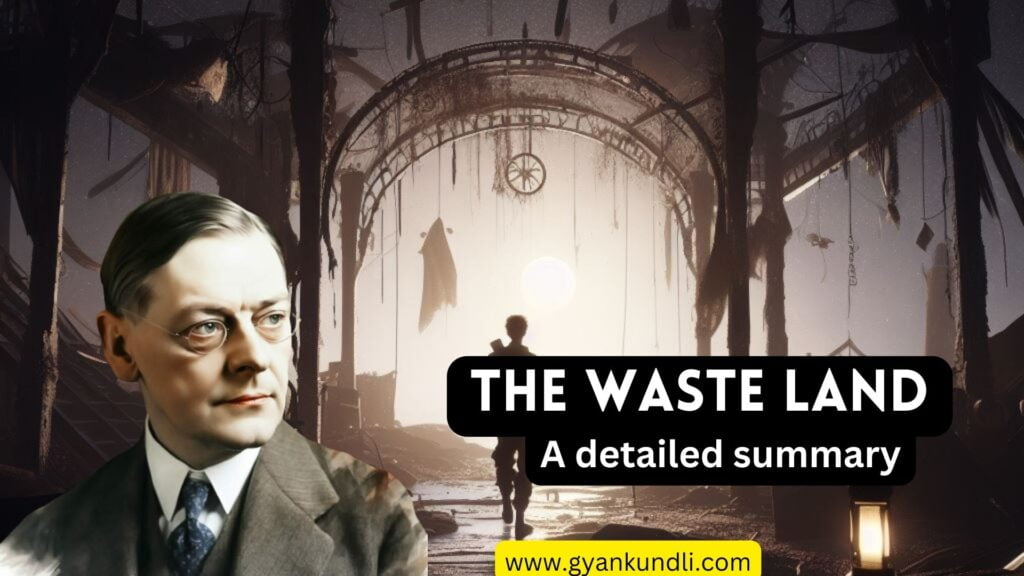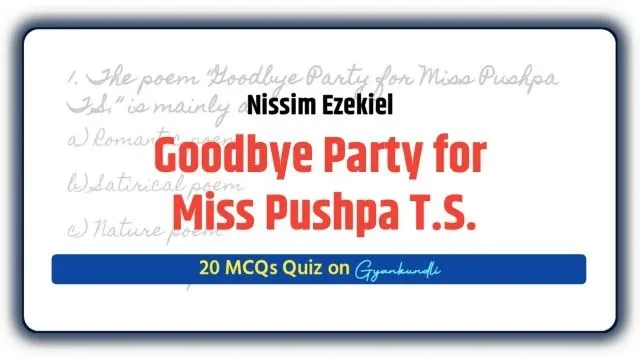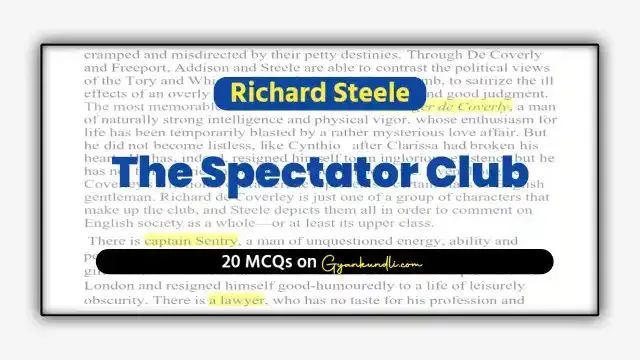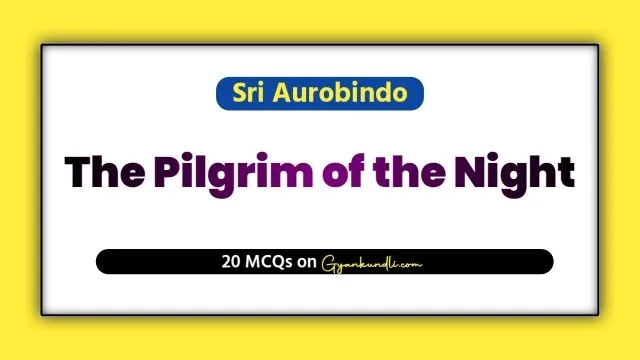“The Waste Land” by T.S. Eliot is a complex and influential modernist poem that consists of five sections: “The Burial of the Dead,” “A Game of Chess,” “The Fire Sermon,” “Death by Water,” and “What the Thunder Said.”

- The Burial of the Dead: In this section, Eliot explores the theme of spiritual desolation in a post-World War I world. He alludes to the biblical story of the resurrection of Lazarus and presents a scene of emotional and psychological decay, reflecting the disillusionment and fragmentation of society.
- A Game of Chess: This section draws inspiration from Shakespeare’s “Antony and Cleopatra” and presents a bleak portrayal of a failed sexual encounter. It explores themes of desire, treachery, and the collapse of communication in a fractured world, highlighting the hopelessness of human connections.
- The Fire Sermon: Eliot examines the consequences of desire and the degradation of modern society. He references the Buddha’s Fire Sermon, highlighting the destructive nature of human desires and the resultant spiritual emptiness. This section underscores the wasteland’s moral decay.
- Death by Water: In this part, Eliot shifts the focus to the element of water, symbolizing purification and rebirth. He uses various mythological and literary references to convey the idea of cyclical renewal, suggesting that even in the wasteland, there is the potential for transformation and growth.
- What the Thunder Said: The final section offers a glimpse of hope and redemption. It describes an apocalyptic scene with rain and thunder, symbolizing rejuvenation and cleansing. The thunder’s voice, potentially divine, hints at the possibility of renewal and spiritual awakening.
“The Waste Land” is a profound exploration of the disillusionment and despair in the aftermath of a world at war. Eliot’s use of literary references, mythology, and vivid imagery portrays a deep sense of despair while also hinting at the potential for renewal and transformation, establishing it as a pivotal work in modernist literature.
Detailed summary of each section of The Waste Land:
1.The Burial of the Dead
“The Burial of the Dead” serves as the opening section of “The Waste Land” and sets the tone for the entire poem. In this section, Eliot paints a bleak picture of a world ravaged by the aftermath of World War I. The title itself alludes to the Christian burial service, emphasizing themes of death, decay, and spiritual desolation.
Eliot uses a variety of literary and mythological references, including the biblical story of the resurrection of Lazarus and the myth of the Sirens. He portrays a world where people are emotionally and spiritually dead, their lives reduced to monotonous routines and empty rituals. The imagery of “unreal city” and “stony rubbish” underscores the lifelessness and desolation of urban existence.
One of the central motifs in this section is the concept of mixing memory with desire. Eliot suggests that people are trapped in a cycle of longing for the past while being unable to escape the present’s emptiness. This inability to reconcile memory and desire symbolizes the spiritual and emotional paralysis that plagues the modern world.
Eliot’s poem is laden with a sense of fragmentation and disconnectedness. He employs a variety of voices and perspectives, creating a cacophony of voices that reflect the fractured nature of society. There’s a sense of disillusionment and alienation, where even human interaction lacks genuine connection.
Overall, “The Burial of the Dead” establishes a grim backdrop for the rest of “The Waste Land.” It highlights the pervasive sense of spiritual decay, disillusionment, and the fragmentation of society in the wake of the First World War, setting the stage for Eliot’s exploration of these themes in subsequent sections.
2. A Game of Chess
“A Game of Chess” is the second section of the poem, and it draws its inspiration from William Shakespeare’s “Antony and Cleopatra.” This section continues to explore themes of disillusionment, lust, and the breakdown of communication in a fragmented world.
The title “A Game of Chess” alludes to the power dynamics and manipulation present in both the Shakespearean play and the contemporary world. It’s a metaphor for the power struggles and sexual politics that Eliot observes in modern society.
The section opens with a scene of an extravagant and opulent woman‘s boudoir, likely representing the excesses and decadence of the upper class in the early 20th century. This scene, reminiscent of a game of chess, symbolizes the calculated and often cruel maneuvers in romantic and sexual relationships. The characters in this section, a man and a woman, engage in a conversation where they talk past each other, emphasizing the lack of genuine communication in their relationship.
Eliot’s use of vivid, sensual imagery creates a stark contrast between the outward opulence and the inner emptiness of the characters. The woman, who appears self-absorbed and dissatisfied, seems to embody a sense of emotional and moral decay. The man, on the other hand, is detached and indifferent.
This section also incorporates references to mythology, including Tiresias, a blind prophet who transitions between genders. Tiresias becomes a symbol of androgyny and duality, highlighting the blurred lines between genders and the idea that individuals in the modern world are disoriented and unable to find their true identities.
“A Game of Chess” underscores the idea that, in the wasteland, relationships are devoid of meaning and genuine connection. Lust and desire are portrayed as empty pursuits, and communication has deteriorated into a series of manipulative exchanges. The section’s fragmented structure and various references contribute to the overall theme of disillusionment and fragmentation in the modern world.
3. The Fire Sermon
“The Fire Sermon,” the third section of the poem, highlights the consiquenses of desire and the decay of modern society. It draws inspiration from the Buddha’s Fire Sermon, which emphasizes the destructive nature of human desires.
The title “The Fire Sermon” alludes to the Buddhist teaching that life is suffering and that desire is the root of suffering. Eliot uses this concept to paint a grim picture of a world consumed by unquenchable desires and their consequences.
The section opens with a bleak portrayal of a desolate, polluted landscape where the river Thames is depicted as a “dull canal” filled with waste. This polluted river symbolizes the spiritual and moral degradation of society, mirroring the polluted state of human desires and relationships.
Eliot presents a series of vignettes that showcase the consequences of unbridled desire. He describes scenes of sexual encounters, disconnected from genuine emotions and driven by lust. There is a sense of moral decay as characters engage in promiscuous acts, mirroring the decay of values in the modern world.
The section references a variety of mythological and literary sources, including the myth of Tiresias, who now appears as a prophet bearing witness to the degradation of humanity. Tiresias, who is both blind and androgynous, represents a figure with unique insight into the world’s corruption.
Throughout “The Fire Sermon,” there is a pervasive sense of disillusionment and despair. Eliot’s use of vivid and often grotesque imagery underscores the emptiness and degradation of human desires. The section serves as a harsh critique of a society where physical pleasure and materialism have overshadowed spiritual and moral values.
Overall, “The Fire Sermon” highlights the consequences of unchecked desire and the moral decay of modern society. It underscores the idea that the pursuit of pleasure and material gain has led to spiritual emptiness and the degradation of human connections, aligning with the larger theme of disillusionment and fragmentation in “The Waste Land.”
4. Death by Water
“Death by Water” is the fourth section of the poem, and it shifts the focus to the element of water, symbolizing purification and rebirth. It represents a contrast to the preceding sections, which explore themes of decay and disillusionment.
In this section, Eliot uses a narrative style to present the story of a drowned sailor. The narrative is simple and direct, contrasting with the complex and fragmented structure of the previous sections. The sailor’s death by water is a stark image, symbolizing both literal drowning and a broader sense of cleansing and renewal.
Eliot makes several references to myth and legend in this section, particularly to the myth of the Sirens and the Fisher King. These references add depth to the narrative and contribute to the poem’s overall themes.
The Fisher King is a figure associated with woundedness and infertility, and his story is linked to the health of the land. By alluding to the Fisher King, Eliot suggests that the wasteland is in need of healing and renewal. The drowned sailor’s story becomes a metaphor for the cycle of life, death, and rebirth.
Overall, “Death by Water” provides a moment of respite from the despair and disillusionment of the earlier sections. It introduces the idea of renewal and transformation, suggesting that even in the wasteland, there is the potential for purification and rebirth. The simplicity of the narrative and the references to myth contribute to the poem’s complexity and offer a glimpse of hope amidst the prevailing sense of decay and fragmentation.
5. What the Thunder Said
“What the Thunder Said” is the final section of the poem, and it offers a glimpse of hope and redemption. It takes its title from the concept of thunder as a symbol of divine revelation and cleansing.
This section opens with an apocalyptic scene of thunder and rain, signaling a dramatic shift from the desolation and decay depicted in earlier sections. The rain serves as a symbol of purification, cleansing the wasteland and renewing the earth. This imagery suggests the potential for rebirth and spiritual awakening.
Eliot employs a range of mythological references in this section, including allusions to Hindu mythology and the Hindu god Shiva, known as the destroyer and creator. These references underscore the themes of destruction and renewal.
The thunder’s voice, described as “Da,” suggests a divine revelation or epiphany. It’s a moment of clarity and insight after the previous sections’ confusion and fragmentation. The thunder’s message remains cryptic, but it hints at the potential for transformation and spiritual awakening. It’s a call to action and a departure from the spiritual desolation depicted earlier in the poem.
Eliot’s use of vivid imagery and allusions contributes to the section’s overall sense of renewal and hope. “What the Thunder Said” acts as a conclusion to the poem, offering a sense of redemption and a potential path forward from the wasteland’s spiritual and moral decay. It suggests that even in the darkest of times, there is the possibility of rebirth and renewal, provided humanity heeds the call for transformation.
Quiz : The Waste Land Quiz
The Waste Land : Conclusion
“The Waste Land” by T.S. Eliot is a seminal modernist poem that portrays the disillusionment and fragmentation of post-World War I society. Divided into five sections, it explores themes of spiritual desolation, the consequences of desire, and the potential for renewal. Through rich imagery, mythological references, and narrative techniques, Eliot presents a bleak and complex vision of a world in decay. However, amidst the despair, the poem hints at the possibility of purification and rebirth, suggesting that even in the wasteland of the modern world, there is the potential for spiritual awakening and renewal, making it a profound and enduring work of 20th-century literature.
Discover more from Gyankundli
Subscribe to get the latest posts sent to your email.















Good Work Mama ji
Thanks @KanhaiyaLal